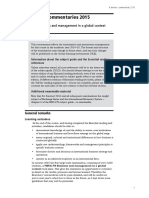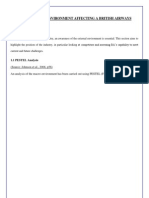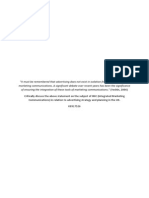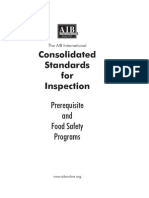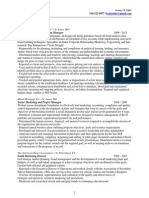TQM in British Airways
TQM in British Airways
Uploaded by
Nazmul Karim TalukderCopyright:
Available Formats
TQM in British Airways
TQM in British Airways
Uploaded by
Nazmul Karim TalukderCopyright
Available Formats
Share this document
Did you find this document useful?
Is this content inappropriate?
Copyright:
Available Formats
TQM in British Airways
TQM in British Airways
Uploaded by
Nazmul Karim TalukderCopyright:
Available Formats
A Report Presented in Partial Fulfillment of the Requirements for the Degree of Masters of Business Administration
AMERICAN INTERNATIONAL UNIVERSITY-BANGLADESH (AIUB) A Group Project Report on TQM in British Airways Supervised by Dr. MD. Mamun Habib
Assistant Professor Faculty of Business Administration
Submitted by
Tanvir Hossain Tanmoy (10-94043-2) Hossain Muhammad Kamal (10-93752-2) A.N.M Tauhiduzzaman (10-94042-2) Md. Ataul Gani (10-94044-2) Nazmul Karim Talukder (10-94041-2)
Major in Operations Management
TQM in BA 2
Date of submission: 24th July, 2011 LETTER OF TRANSMITTAL
24th July, 2011 Dr. Md. Mamun Habib Assistant professor, Department of Business Administration American International University-Bangladesh, Dhaka. Permission for submitting the Group Project Report Dear Sir, This is our great honor to submit the report of our Total quality Management course in the British Airways (BA). The report titled TQM in British Airways under the supervision of Dr. Md. Mamun Habib, Assistant Professor, and kind supervision. In this endeavor, this report seeks to identify how British Airways maintains Total quality Management in their operations. We have gathered information as much as possible. We tried to gather secondary data. Much of our secondary data came from different web sites and partly from Total Quality Managemant books. We enjoyed working on this report and hope you will find it innovative. Thanking you Sincerely yours, Tanmoy, Tanvir Hossain Class Id: 10-94043-2 Hossain, Muhammad Kamal Class Id: 10-93752-2 Tauhiduzzaman, A.N.M Class Id: 10-94042-2 Gani, Md. Ataul Class Id: 10-94044-2 Talukder, Nazmul Karim
.. .. .. ..
TQM in BA 3 Class Id: 10-94041-2 ..
ACKNOWLEDGEMENT
All praises to the Almighty Allah, who has bestowed his kindness upon us by giving us the opportunity, time, courage, strength and patience to carry out and complete the report properly. Firstly, we would like to remember the contribution of our parents for their proper guidelines. Special thanks goes to our teacher Dr. Md. Mamun Habib, Assistant Professor, Faculty of Business administration of AIUB who was with us like shadow to advice us how to work.
Lastly, we also thank all of our friends who helped us instantly or via phone or e-mail.
Group: A 24/07/2011
TQM in BA 4
Table of Contents
PARTICULARS Cover Page Letter of Transmittal Acknowledge Chapter 1: Introduction 1.1 Definition of TQM 1.2 Scope and delimitation of the Study 1.3 Objectives Chapter 2: Literature Review 2.1 TQM Six basic concept 2.2 Strategic Grid 2.3 Quality Statements Chapter 3: Discussion 3.1 SWOT Analysis of British Airways 3.2 TQM Six basic Concepts 3.3 Strategic Grid analysis 3.4 Quality Statements of British Airways Chapter 4: Suggestions 4.0 Suggestion Chapter 5: Conclusion 5.0 Conclusion Reference
PAGE NO
04-05 04 05 05 6-11 6-8 8-10 10-11 12-16 12 13-14 15 16 17 17 18 18
1.0 Introduction
1.1 Definition of Total Quality Management (TQM)
TQM in BA 5 TQM is a management philosophy, a paradigm, a continuous improvement approach to doing business through a new management model. The TQM philosophy evolved from the continuous improvement philosophy with a focus on quality as the main dimension of business. Under TQM, emphasizing the quality of the product or service predominates. TQM expands beyond statistical control to embrace a wider scope of management activities of how we manage people and organizations by focusing on the entire process, not just simple measurements. TQM is a comprehensive management process which: Focuses on meeting owners/customers needs by providing quality services at a cost that provides value to the owners/customers. Is driven by the quest for continuous improvement in all operations. Recognizes that everyone in the organization has owners/customers who are either internal or external. Views an organization as an internal system with a common aim rather than as individual departments acting to maximize their own performances. Emphasizes teamwork and a high level of participation by all employees.
In a simple way Total Quality management means that the organizations culture is defined by and supports the constant attainment of stakeholders satisfaction through an integrated system of tools, techniques, and training. This involves the continuous improvement (kaizen) of organizational processes, resulting in high quality products and services.
1.2 Scope and delimitation of the Study:
Among the various departments of British Airways (BA), this report focuses on strategic planning and implementation and service performance according to total quality management (TQM) concept. Information has been collected from different websites.
TQM in BA 6 The time frame for conducting this study is limited. Constraint of analyzing with the primary data may have hindered this study from being comprehensive.
1.3 Objectives
Primary Objectives Study on the TQM in British Airways.
Secondary Objectives . Analyzing the organizational TQM thought at BA. Analyzing the strategic issues in terms of TQM at BA. Analyzing their service array from the view of TQM.
2.0 Literature Review:
2.1 TQM Six basic concept
TQM in BA 7 According to Besterfield(2003), TQM requires six basic concepts: 1. A committed and involved management to provide long-term top-to-bottom organizational support. 2. An unwavering focuses on the customer, both internally and externally. 3. Effective involvement and utilization of the entire work force. 4. Continuous improvement of the business and production process. 5. Treating suppliers as partners. 6. Establish performance measures for the processes. These concepts outline an excellent way to run an organization. A brief paragraph on each of them is given below: A committed and involved management to provide long-term top-to-bottom organizational support: Management must participate in the quality program. A quality council must be established to develop a clear vision, set long- term goals, and direct the program. Quality goals are included in the business plan. An annual quality improvement program is established and involves input from the entire work force. Managers participate on quality improvement teams and also act as coaches to other teams. TQM is a continual activity that must be entrenched in the culture-it is not just a one shot program. TQM must be communicated to all people.
An unwavering focuses on the customer, both internally and externally:
The key to an effective TQM program is its focus on the customer. An excellent place to start is by satisfying internal customers. We must listen to the voice of the customer
TQM in BA 8 and emphasize design quality and defect prevention. Do it right the first time and every time, for customer satisfaction is the most important consideration. Effective involvement and utilization of the entire work force
TQM is an organization-wide challenge that is everyones responsibility. All personnel must be trained in TQM, statistical process control (SPC), and other appropriate quality improvement skills so they can effectively participate on project teams. Including internal customers and, for that matter, internal suppliers on project teams are an excellent approach. Those affected by the plan must be involved in its development and implementation. They understand the process better than anyone else. Changing behavior is the goal. People must be empowered at the lowest possible level to perform processes in an optimum manner. Continuous improvement of the business and production process
There must be a continual striving to improve all business and production process. Quality improvement projects, such as on-time delivery, order entry efficiency, billing error rate, customer satisfaction, cycle time, scrap reduction, and supplier management, are good places to begin. Technical techniques such as SPC, benchmarking, quality function deployment, ISO 9000, and designed experiments are excellent for problem solving. Treating suppliers as partners.
On the average 40% of the sales dollar is purchased product or service; therefore, the supplier quality must be outstanding. A partnering relationship rather than an adversarial one must be developed. Both parties have as much to gain or lose based on the success or failure of the product or service. The focus should be on quality and life-cycle costs rather than price. Suppliers should be few in number so that true partnering can occur.
TQM in BA 9 Establish performance measures for the processes.
Performance measures such as uptime, percent nonconforming, absenteeism, and customer satisfaction should be determined for each functional area. These measures should be posted for everyone to see. Quantitative data are necessary to measure the continuous quality improvement activity. The purpose of TQM is to provide a quality product and/or service to customers, which will, in turn, increase productivity and lower cost. With a higher quality product and lower price, competitive position in the marketplace will be enhanced. This series of events will allow the organization to achieve the objectives of profit and growth with greater ease. In addition, the work force will have job security, which will create a satisfying place to work. In the next chapter we are trying to analyzing these concepts on British Airways.
2.2 Strategic Grid
Samuel (2004) analyzed about the Strategic Grid; Strategy to be evolved in quality management depends on both thinking and planning process. This is explained in strategic grid below: Strategic Planning Good Good Strategic Thinking Bad 3 4 1 Bad 2
Strategic thinking attempts to determine the what of corporate visioning while the strategic planning looks at how to achieve that vision. The various possibilities are explained as follows:
TQM in BA 10
Strategic thinking and planning is well done. In this quadrant there is a clear Quadrant 1: picture of the organizations future. Operational competency is exists. This is practiced by successful companies Successful strategic thinking but strategic Quadrant 2: planning is poor. There is a clear picture of the future, while implementation strategy is ineffective. Good strategic planning but poor strategic thinking. Quadrant 3: In this quadrant ongoing operations are managed successfully. But the organizations are uncertain about the future profile. Strategic thinking and strategic planning poor. This quadrant depicts the uncertain Quadrant 4: vision of the future. Also incompetent in operational functioning. Companies dont survive very long following this strategy.
Companies in Quadrant 4 should bring in tremendous changes in the organization. The organization need to relook at their organization structure, personnel and methods. People who have a vision and who would work towards the vision have to be brought into the organization. Inefficient process and ineffective methods have to be removed. Organizations in Quadrant 3 are placed in a situation where manpower is available to implement the directions. The need is for visionary leaders who can foresee into the future and be proactive. Organizations in Quadrant 2 have good thinkers but rare doers. The ideas and visions postulated have to be implemented by the members of the organization. Quadrant 1 is the ideal situation which every organization needs to aim and
TQM in BA 11 achieve. In our next chapter we analyzed the position of British Airways under this grid concept.
2.3 Quality Statements
Besterfield (2003) also analyzed the Quality Statements. From his view; in addition to the core values and concepts, the quality statements include the vision statement, mission statement, and quality policy statement. Once developed, they are only occasionally reviewed and updated. They are part of the strategic planning process. The utilization of the three statements varies considerably from organization to organization. In fact, small organization may use only the quality policy statement. Additionally, there may be considerable overlap among the statements. Opinion regarding Vision Statement, Goals and Objectives of Berterfield (2003) are as follows: Vision Statement The vision statement is a short declaration of what an organization aspires to be tomorrow. It is the ideal state that might never be reached, but which you continually strive to achieve. Successful visions provide a succinct guideline for decision-making. Having a concise statement of the desired end provides criteria for sound decision making.
Goals and Objectives Goals and objectives have basically the same meaning. However, it is possible to differentiate between the two by using goals for long-term planning and objectives for short-term planning. The goal is to win the war; the objective is to capture the bridge.
TQM in BA 12 Concrete goals are needed to provide a focus, such as improve customer satisfaction, employee satisfaction, and processes. Goals can force changes in leadership style from reward and punishment to identifying and improving system problems. Goals must be based on statistical evidence. Without statistical knowledge of the system,goals merely reflect the assumption that slogans, exhortations, and hard work will miraculously change the system. Goals must be definitive, specific, and understandable, using concrete results rather than behaviors or attitudes. The most important characteristics of goals is that they be measurable. Only measurable goals can be evaluated. Goals must have a plan or method with resources for its achievement. If there is not a cause-and-effect relationship between the goals and the method, then the goal is not a valid one. In addition, a specific timeframe or deadline for achieving the goal should be given. Goal must be challenging yet achievable. Those individuals, work groups, departments, and functional areas that are affected by the goals should be involved in their development. Stretch goals are satisfactory, provided they are based on benchmark data. The characteristics of objectives are identical to those given here for goals. They are operational approaches to attain the goals. We are trying to find the impact of the quality statements of British Airways in the next part of the report.
3.0 Discussion
3.1 SWOT Analysis of British Airways
TQM in BA 13 SWOT analysis is a strategic planning method used to evaluate the Strength, Weakness, Opportunities, and Threats involved in projector in a business venture or project and identifying the internal and external factors that are favorable and unfavorable to achieve the organizational objective. SWOT Analysis of British Airways
Strength
Reputable Brand Name International Operation Employee Productivity Skilled Staff Heathrow Terminal 5 Customer Loyalty program Expansion of fleet Aircraft.
Weakness
Cost of Management Labor strikes and poor employee relation history Cost of Flight Outsourcing
Opportunities
Global Airline Market Skytrax Quality System Establishing Manufacturing Unit Emergence of New Market Growing Asia-Pacific Market. Labor Market
Threat
Government Interventions
Rising International Fuel rises Rapid change in Technology Consumer Behavior Global Economic Crisis.
3.2 TQM Six basic Concepts
1. Management Commitment to TQM principles and methods & long term quality plans for the Organization
TQM in BA 14 British Airways applied TQM concept in their organization with a long term plan and by the end of 1999 they started getting benefits of TQM concept. At different times the management of British Airways took different plans for the improvement of their company. BA spends a huge amount of money for the development of their employees. They are merging with other airlines to provide better service. British Airways has expanded its fleet aircrafts as recently in January 2011, the merger between British Airways and Iberia will create the world's third-largest airline in terms of annual revenue and the second largest airline group in Europe. Not only this, but British Airways has also placed firm orders for 24 Boeing 787s, which will replace the oldest Boeing 767s in the fleet from 2012. To change the organization culture BA took a very long term and expensive training program for their managers. 2. Focus on customers- Internal & External The aim of BA to provide a premium service to all their customers at every touch point, providing comfort, convenience and reliability. The main focus of British Airways is their external customer. They are always changing their old aircrafts so that they can provide better service to their customer. They provide special privileges to their business class passengers. BA provides special training to customer-facing employees to ensure customer satisfaction. For their internal customers at different times they tried to develop different types of payment structure. BA provides training to their employees to increase productivity & efficiency of the employee. 3. Quality at all levels of the workforce British Airways has been the first one to start Training centre program therefore its employees are more productive and well trained in their specific jobs. To provide quality service to their customers BA trains all the employees of the company. BA is spending huge amount of money, effort and time to assure the quality of all levels of their workforce. They design the training programs based on the tasks. 4. Continuous improvement of the production business process
TQM in BA 15 British Airways is always trying to improve their quality. The target of BA is to provide premium quality service to their customers. BA is always considering the customer feedback and opinion with maximum importance and investing to those product and services to improve product and service quality. 5. Treating suppliers as partners BA had very long term relation with Boeing. They were a loyal customer of Boeing till 1998. Considering their requirement to provide quality service from 1998 they also become a customer of Airbus. Now, British Airways a customer of both Boeing and Airbus. BA is determined to build strong and trusted relationships with their supply partners. 6. Establish performance measures for the process British Airways has identified 5 indicators to measures their performance. Colleagues Customer Performance Excellence Partnerships
After evaluating these indicators they measure the progress of the process. Then based on the performance measurement they take further action.
3.3 Strategic Grid analysis
Strategic Planning
TQM in BA 16
Good Good Strategic Thinking Bad 3 1
Bad 2
Fig.: Strategic Grid Quadrant 2: Successful strategic thinking but strategic planning is poor. Clear picture of the future, implementation of the strategy is ineffective The British Airways top management always gave emphasize on the continuous improvement of the organization. They set clear picture of the future but because of improper implementation of the strategy British Airways did not get the expected result. Like, Top management of British Airways decided to build booking information system to help the customer. But, later it was misused to attract customer. As a result BA faced huge legal procedure and a large amount of penalty. At different times British Airways developed different plans for improvement but the plans were not communicated with the employees properly or the information flow was not proper. It created conflicts between the employees and the management. As a result BA is facing loss in the current years. At different time the top management took different steps to expand the business and give better service to the customer but because of poor implementation plan they were not fruitful. Like, when they merged with other airlines to expand their business and increase their market share they faced different problems after implementation. Because, they did not consider all the factors in their implementation plan. Their vision was good but they had problem in their strategic planning.
3.4 Quality Statements of British Airways
Vision Statement To become the worlds leading global premium airlines.
TQM in BA 17
Strategic Goal and Objectives They have five strategic goal and objectives: 1. Be the airline of choice for long haul premium customer. 2. Deliver an outstanding service for customers at every touch point. 3. Grow our presence in key global cities. 4. Build on our leading position in London. 5. Meet our customers needs and improve margins through new revenue streams. From their quality statements it seems that to attain their vision they fix up different dynamic strategic goals and objectives. In a real circumstance it shows they are not much more successful to meet their targets and the reasons already verifying in the previous analysis.
4.0 Suggestions
After analyzing the various internal and external strategic factors would recommend the British Airways to make their HR department more active in the process of keeping the employees more motivated and training. It should introduce more flexible
TQM in BA 18 grievances handling programme and adequate compensation plan which keeps the strikes and blockages far from the process. BA must diversify by entering into new business ventures and should go for to manufacture their own manufacturing units so that their dependency on others decreases more. It has to keep a regular check on the quality review airlines system in order to attain and retain its strong position in the dynamics of the environment. It must have a good and defensive market strategy so that the rivals not out class them by low fares. BA has to keep a good review on the chain that where is the loophole or break in the value chain, is it the customer analysis, employee relations, innovations or any other factor that is creating a blockage in the progress.
5.0 Conclusion
To put it in a nutshell, BA is one of the most developed and well established Airlines in the world today and it has the great potential to increase its market share. There has been recent merger with Iberia and now it has 55% market share were as Iberia has 45% share
TQM in BA 19 in market. BA has 13.5% stakes currently which shows its credibility. It is also planning to have its merger with Air India in upcoming years. It has the skilled and developed labor force which is good sign but they should develop some good solid plans to control these strikes and picketing. It has every opportunity to expand more and more by increasing its training units, establishing its own manufacturing industries and diversify into other transports. BA also has to develop a good plan to meet all the threats in an appropriate way. To compete in 2012, this is the target and goals that BA has mentioned in its Annual Report 2010. BA has a plan and it has classified how to meet these targets in the future.
TQM in BA 20
Bibliography
Anonymous (February, 2010). Quality and System Management of British Airways Retrieved July 15, 2011 on the World Wide Web: http://ivythesis.typepad.com/term_paper_topics/2010/02/strategic-objectives-ofoperations-management-and-british-airwayss-operations-management.html
Wikipedia. British Airways Retrieved July 15, 2011 on the World Wide Web: http://en.wikipedia.org/wiki/British_airways
TQM in BA 21
British Airways (2010). 09/10 Annual Report and Accounts. Retrieved July 15, 2011 on the World Wide Web: http://www.britishairways.com/cms/global/microsites/ba_reports0910/corpgov/re m_audit2.html Rawlins R. A. (2008). Total Quality Management. UK: AuthorHouse UK. Ltd. Anonymous (2011). New route to customer service. Retrieved July 15, 2011 on the World Wide Web: http://www.slideshare.net/iipmff2/atqmcasestudyinservicesector-british-airways Bank, J. (2002). The Essence of TQM. UK: Prentice-Hall International
You might also like
- British AirwaysDocument21 pagesBritish AirwaysAadil KakarNo ratings yet
- ASDM Group Assignment PDFDocument30 pagesASDM Group Assignment PDFChellappan Thirunavukkarasu50% (2)
- 66851Document30 pages668519600257003No ratings yet
- DJBDocument11 pagesDJBAbi AbyiNo ratings yet
- Marketing Fundamentals: Assignment No: 2 Assignment Title: Individual Essay and ReflectionDocument15 pagesMarketing Fundamentals: Assignment No: 2 Assignment Title: Individual Essay and ReflectionFahim KhanNo ratings yet
- Leadership Complexity and Change - Mandhu CollegeDocument13 pagesLeadership Complexity and Change - Mandhu CollegeMohamed AbdullaNo ratings yet
- Case 1 - TQMDocument8 pagesCase 1 - TQMladdooparmarNo ratings yet
- Financial Analysis-Southwest AirlinesDocument16 pagesFinancial Analysis-Southwest AirlinesManish Kumar100% (8)
- 7L. Porter Five Forces ModelDocument33 pages7L. Porter Five Forces ModelTanpreet BenipalNo ratings yet
- ADL41Document9 pagesADL41shreekumar_scdl0% (1)
- Case Study 3Document6 pagesCase Study 3May Teng0% (1)
- New Advance AssignmentDocument17 pagesNew Advance AssignmentJoli PhamNo ratings yet
- Virgin Trains Case StudyDocument5 pagesVirgin Trains Case StudyPage MirerzNo ratings yet
- mn1178 Exc15Document18 pagesmn1178 Exc15Chloe Tham100% (1)
- Parts Manual PN103-001 - Schramm - Edm - Rod Handler 0 - 2Document59 pagesParts Manual PN103-001 - Schramm - Edm - Rod Handler 0 - 2frfgf100% (4)
- Implementation of Total Quality Management by British AirwaysDocument11 pagesImplementation of Total Quality Management by British Airwayssrujan100% (4)
- Assignment/Project Front Sheet: CIM Membership NumberDocument59 pagesAssignment/Project Front Sheet: CIM Membership Numberحازم صبحى100% (1)
- Micro Environment Air AsiaDocument9 pagesMicro Environment Air AsiaKeith PerkinsNo ratings yet
- Marketing Research Design: A Case Study of Extreme Rock Climbing CentreDocument12 pagesMarketing Research Design: A Case Study of Extreme Rock Climbing Centreklm klmNo ratings yet
- Assessment 1 Strategic MarketingDocument17 pagesAssessment 1 Strategic MarketingTamika InglisNo ratings yet
- CT 4 Id 18241039Document3 pagesCT 4 Id 18241039SaKib AbdullahNo ratings yet
- DBGI SM0380 w13034743 Michael BeiserDocument21 pagesDBGI SM0380 w13034743 Michael BeiserAlee Low100% (1)
- Pillars of TQM Implementation in Manufacturing Organizationan Empirical StudyDocument14 pagesPillars of TQM Implementation in Manufacturing Organizationan Empirical StudyIbrahimMustefaNo ratings yet
- The External Environment Affecting A British AirwaysDocument13 pagesThe External Environment Affecting A British Airwayskunal ladNo ratings yet
- Review of Literature ErpDocument10 pagesReview of Literature ErpSiva KalimuthuNo ratings yet
- Business Integration Project 2 RESIT Summative Assessment Brief PDFDocument16 pagesBusiness Integration Project 2 RESIT Summative Assessment Brief PDFRobert BcgNo ratings yet
- Oasis AirlineDocument5 pagesOasis AirlineRd Indra AdikaNo ratings yet
- Assignment#1 Leadership Skills Analysis INDIVIDUAL - Summer - 2023Document3 pagesAssignment#1 Leadership Skills Analysis INDIVIDUAL - Summer - 2023ODIPLEXNo ratings yet
- ALUXTELDocument2 pagesALUXTELRabiya MughalNo ratings yet
- Singapore Airlines Report On Strategic Alliance and Political RiskDocument11 pagesSingapore Airlines Report On Strategic Alliance and Political Risksanketdaga0% (1)
- SSRN Id2292797Document14 pagesSSRN Id2292797scsew8332No ratings yet
- Assignment Arla FoodsDocument10 pagesAssignment Arla FoodsAhsan Sarwar NabilNo ratings yet
- Individual ProjectDocument8 pagesIndividual Projectayan biswasNo ratings yet
- CRM - Final Project GuidelinesDocument7 pagesCRM - Final Project Guidelinesapi-283320904No ratings yet
- Starbucks Corporation Organizational BehaviourDocument8 pagesStarbucks Corporation Organizational BehaviourSatrio HaryosenoNo ratings yet
- Relationship Marketing - ToyotaDocument6 pagesRelationship Marketing - ToyotaCynthia ChuaNo ratings yet
- Airasia Case StudyDocument11 pagesAirasia Case StudyMillyNo ratings yet
- Chapter 01Document42 pagesChapter 01Yuan ThongNo ratings yet
- Business StatisticsDocument21 pagesBusiness StatisticsSukanya SomNo ratings yet
- ASDM Assignment Housing 2010-11Document14 pagesASDM Assignment Housing 2010-11Mohd_ADNo ratings yet
- STARBUCKSDocument9 pagesSTARBUCKSJeric john TorresNo ratings yet
- Market Segmentation AssignmentDocument18 pagesMarket Segmentation AssignmentVrindha Vijayan100% (1)
- UMACRQ-15-M Strategic Management Accounting: Session 6: Activity-Based Costing (ABC) RevisitedDocument24 pagesUMACRQ-15-M Strategic Management Accounting: Session 6: Activity-Based Costing (ABC) RevisitedAhmed MunawarNo ratings yet
- Virgin Atlantic Marketing TriangleDocument44 pagesVirgin Atlantic Marketing Triangleavneeshbansal1993100% (1)
- CSR Activities of WalmartDocument4 pagesCSR Activities of WalmartMamta Narula100% (2)
- Refrence LetterDocument3 pagesRefrence LetterNasir JamalNo ratings yet
- British Airways Market Insight ReportDocument5 pagesBritish Airways Market Insight ReportBea BoocNo ratings yet
- Some Marketers Feel That The Image of The Particular Channel in Which They Sell Their Products Does Not Matter-AllDocument1 pageSome Marketers Feel That The Image of The Particular Channel in Which They Sell Their Products Does Not Matter-AllHarriet BlaireNo ratings yet
- Recruitment Process of UBL Bank:: Analysis Technique (A Forecasting Technique For Determining Future Staff Needs byDocument3 pagesRecruitment Process of UBL Bank:: Analysis Technique (A Forecasting Technique For Determining Future Staff Needs byMohsin AliNo ratings yet
- Iqra UniversityDocument15 pagesIqra Universityrehman hingoraNo ratings yet
- Analysing Apple'S Strategies To Build and Sustain Competitive AdvantageDocument30 pagesAnalysing Apple'S Strategies To Build and Sustain Competitive AdvantageVishakha Rl RanaNo ratings yet
- Group H Macroeconomics Germany InflationDocument13 pagesGroup H Macroeconomics Germany Inflationmani kumarNo ratings yet
- Integrated Marketing Communication AssignmentDocument7 pagesIntegrated Marketing Communication AssignmentKasim JayNo ratings yet
- Walmart Value ChainDocument4 pagesWalmart Value ChainManvinder Bali100% (1)
- Strategic Marketing Management MKT-522 Term Paper-Fall 2021 On Value Chain Model of "Shawpno Bangladesh"Document5 pagesStrategic Marketing Management MKT-522 Term Paper-Fall 2021 On Value Chain Model of "Shawpno Bangladesh"Tonmoy Dev PrithuNo ratings yet
- Emerging ThemesDocument2 pagesEmerging ThemesAhmad HaqqiNo ratings yet
- Om AssignmentDocument4 pagesOm AssignmentAditya Batra100% (1)
- PGMB136: International Human Resource Management Assessment Student Name Student IdDocument12 pagesPGMB136: International Human Resource Management Assessment Student Name Student IdasadNo ratings yet
- Assignment 1Document2 pagesAssignment 1Carlos Arturo AlanizNo ratings yet
- Calculate Customer Lifetime Value A Clear and Concise ReferenceFrom EverandCalculate Customer Lifetime Value A Clear and Concise ReferenceNo ratings yet
- AIB Food Safety Eng Man WebDocument118 pagesAIB Food Safety Eng Man WebAchmad IrwantoNo ratings yet
- Marketable Avenues: 14,15,16 April 2023Document31 pagesMarketable Avenues: 14,15,16 April 2023Avaneesh Natraj GujranNo ratings yet
- History of The California EndowmentDocument65 pagesHistory of The California EndowmentRetiremapNo ratings yet
- Nirma ProjectDocument26 pagesNirma ProjectAnil ChauhanNo ratings yet
- ACCT101 - Prelim - THEORY (25 PTS)Document3 pagesACCT101 - Prelim - THEORY (25 PTS)Accounting 201100% (1)
- Memorandum: Type # 1. Request MemoDocument13 pagesMemorandum: Type # 1. Request MemoZahid BashirNo ratings yet
- Human Resources in Health Care: Keerti Bhusan PradhanDocument11 pagesHuman Resources in Health Care: Keerti Bhusan PradhanMuhrawi YundingNo ratings yet
- Decision Making and HappinessDocument5 pagesDecision Making and HappinessTactics HerosNo ratings yet
- Week 10 Trade Financing ImportersDocument14 pagesWeek 10 Trade Financing ImportersJ DreamerNo ratings yet
- Marketing Manager Coordinator Programs in Dallas FT Worth TX Resume KeJaun DuBoseDocument2 pagesMarketing Manager Coordinator Programs in Dallas FT Worth TX Resume KeJaun DuBoseKeJuanDuBoseNo ratings yet
- Bakari KuweDocument12 pagesBakari KuweHussein ShaabanNo ratings yet
- INNOVATORS - Company ProfileDocument3 pagesINNOVATORS - Company Profileamit kaneNo ratings yet
- Standards On Water Meters: February 2018Document10 pagesStandards On Water Meters: February 2018Tejasree NaredlaNo ratings yet
- YTL Cement Berhad - Annual Report 2011Document130 pagesYTL Cement Berhad - Annual Report 2011Syukran RazakNo ratings yet
- Chapter 8 Ecommerce SystemDocument3 pagesChapter 8 Ecommerce SystemRazib DasNo ratings yet
- Economic Glossary: Union BudgetDocument3 pagesEconomic Glossary: Union BudgetSanjay kumarNo ratings yet
- LcaDocument13 pagesLcanor_tahir_6No ratings yet
- Fitsum Getu Feyissa CV PDFDocument11 pagesFitsum Getu Feyissa CV PDFFitse GetuNo ratings yet
- Soal Bahasa Inggris Xii Ayu AzrurinDocument24 pagesSoal Bahasa Inggris Xii Ayu AzrurinAyu AzrurinNo ratings yet
- Afase Open Letter Signatories 130403Document31 pagesAfase Open Letter Signatories 130403solarpowerportalNo ratings yet
- Benn Jordan - The Revolution of Greed and The Music IndustryDocument9 pagesBenn Jordan - The Revolution of Greed and The Music IndustryPedro LopezNo ratings yet
- D10 CaDocument4 pagesD10 CaaskermanNo ratings yet
- Real Options and Other Topics in Capital BudgetingDocument24 pagesReal Options and Other Topics in Capital BudgetingAJ100% (1)
- Graduate List 2019 Jun06 10amDocument4 pagesGraduate List 2019 Jun06 10amHamdardvir Singh BoparaiNo ratings yet
- Forum 1Document1 pageForum 1Nurul AryaniNo ratings yet
- Indirect Source To Pay OverviewDocument4 pagesIndirect Source To Pay OverviewLionelkeneth12No ratings yet
- ISO 9001 Internal Auditor PDFDocument1 pageISO 9001 Internal Auditor PDFAvinash KumarNo ratings yet
- Artikel TriveliaDocument18 pagesArtikel TriveliaEzra SilalahiNo ratings yet
- Tendering Assignment Qs 37Document51 pagesTendering Assignment Qs 37Prasad RajapakshaNo ratings yet













